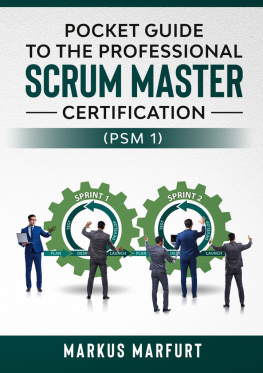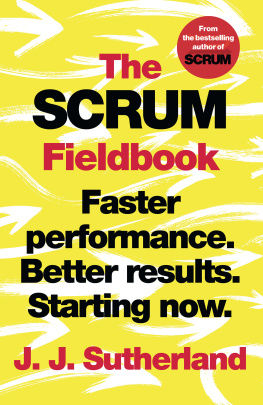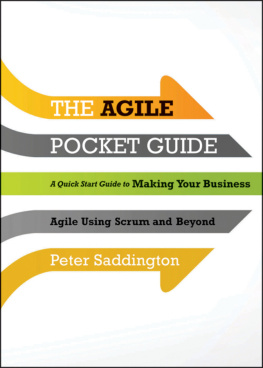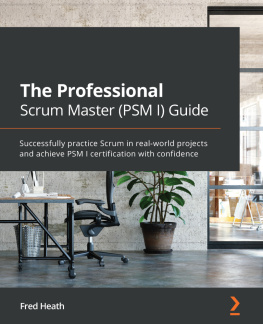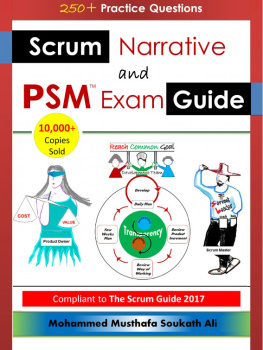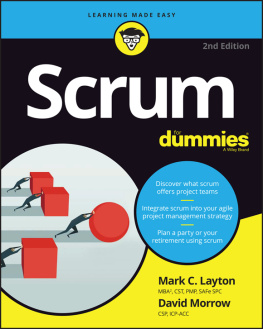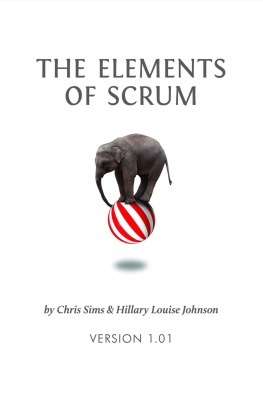Heath Herel - Practical Scrum: A Users Guide
Here you can read online Heath Herel - Practical Scrum: A Users Guide full text of the book (entire story) in english for free. Download pdf and epub, get meaning, cover and reviews about this ebook. year: 2020, genre: Home and family. Description of the work, (preface) as well as reviews are available. Best literature library LitArk.com created for fans of good reading and offers a wide selection of genres:
Romance novel
Science fiction
Adventure
Detective
Science
History
Home and family
Prose
Art
Politics
Computer
Non-fiction
Religion
Business
Children
Humor
Choose a favorite category and find really read worthwhile books. Enjoy immersion in the world of imagination, feel the emotions of the characters or learn something new for yourself, make an fascinating discovery.

- Book:Practical Scrum: A Users Guide
- Author:
- Genre:
- Year:2020
- Rating:3 / 5
- Favourites:Add to favourites
- Your mark:
- 60
- 1
- 2
- 3
- 4
- 5
Practical Scrum: A Users Guide: summary, description and annotation
We offer to read an annotation, description, summary or preface (depends on what the author of the book "Practical Scrum: A Users Guide" wrote himself). If you haven't found the necessary information about the book — write in the comments, we will try to find it.
Practical Scrum: A Users Guide — read online for free the complete book (whole text) full work
Below is the text of the book, divided by pages. System saving the place of the last page read, allows you to conveniently read the book "Practical Scrum: A Users Guide" online for free, without having to search again every time where you left off. Put a bookmark, and you can go to the page where you finished reading at any time.
Font size:
Interval:
Bookmark:
Practical Scrum:
A Users Guide
Heath H Herel
All text and images 2020 Heath Herel
All rights reserved. No part of this publication may be reproduced, stored in or introduced into a retrieval system, or transmitted, in any form, or by any means (electronic, mechanical, photocopying, recording or otherwise) without the prior written permission of the publisher. Any person who does any unauthorized act in relation to this publication may be liable for criminal prosecution and civil claims for damages.
This book is sold subject to the condition that it shall not, by way of trade or otherwise, be lent, re-sold, hired out, or otherwise circulated without the publishers prior consent in any form or binding or cover other than that in which it is published and without a similar condition including this condition being imposed on the subsequent purchaser.
Published January 2020
Cover design by Toni Norcross
ISBN 978-1674105062
Contents
Scrum (n): A framework within which people can address complex adaptive problems, while productively and creatively delivering products of the highest possible value.
Ive written a lot of words over the last 10 years or so about Scrum. I have talked about Scrum at work, at home, and even on the set of Jeopardy! when asked by Alex Trebek what a Scrum Master is. Ive been told I am a walking commercial for Scrum. Like many of you reading this, I believe in Scrum to my very core. I have seen what it can do when it works, and how it can transform the way we work into something exciting and dynamic. I have also seen my share of problems and challenges arise. I have attended classes and conferences, and taken numerous certification exams to challenge myself and verify (to myself) that I have gained the knowledge I desire.
In my blog I have written about many of my personal observations (and I will undoubtedly continue to do so), and you will find the genesis of many parts of this book in my blog. Some of it is copied here almost word for word. It is these very observations that drove me to write this book to talk about what works and what doesnt from my own perspective; not from the perspective of a professional trainer or consultant, but from someone who is in the trenches with Scrum Teams on a daily basis.
Not everything in here will apply to you, to your situation, or to your organization. There might even be things I have written here that you strongly disagree with. Thats cool. I dont think anyone can write a book with personal insights and tips that will be all things to all readers. Hopefully, you can find something in here that does appeal to you and that provides guidance or makes you think a little bit.
If you pull only two things from this book, let it be these:
Do what is right for your team.
When in doubt, ask your team.
What works perfectly for one team might not for another. It is important that we are as Agile as we want our teams to be. Dont be afraid to experiment and see what works. I tell everyone that we can try anything for a Sprint or three and see if it works for us. It is through this constant experimentation, and a frequent Inspect and Adapt cycle, that we transform how we work and truly gain the benefits of Agile. Dont be afraid to get outside of your own comfort zone, and dont be afraid to have FUN. Specific tactics for how you use the Scrum framework can, and should, vary based on what your team requires. While it is important that you don't leave out parts of Scrum, it's also important that you aren't acting as the Scrum police and enforcing every little thing along the way. The Scrum Team needs room to breathe and find what is going to work best for them.
Ultimately, the best way to know whats right for your Scrum Team is often to simply ask them. Theres something you want to have them try to do? Ask them. Theres a question about whether something extra can be done in the current Sprint? Ask them. You want to get ice cream or craft beers for the team and dont know what to buy? Ask them. Not all questions have to be serious, business-oriented ones, after all. Trust your team. They know what is best for them.
You absolutely have to do everything that is in the Agile framework your organization is using. That's important. But what makes a difference and makes your teams truly Agile is the understanding of why it is important. This book is focused on Scrum because thats where my expertise lies, but much of what is here applies to any Agile framework your team(s) might be using. It's also critical to recognize that you can't just keep working in the same old ways but use the Scrum terminology, because nothing will change. Scrum is not about micromanaging your teams, it relies on empowering your teams and letting them make the right choices for your product.
This book is intentionally short and written in brief easily-digestible sections. Feel free to skip around and find the parts that are important to you. This isnt a Scrum 101 book, but there are definitely pieces here that focus on what to do. Hopefully what follows will help guide you as to why we do it.
Chapter I - Introduction discusses whether we are Doing Agile or Being Agile and the important difference between the two. Here we also meet the Team we will be working with periodically throughout the course of this book.
Chapter II - A Tale of Three Transformations recounts an actual Agile Transformation that I was an integral part of. There were mistakes made and lessons learned, and much of what happened and is shared here sets the stage for the rest of this book, as it did for my career in Scrum.
Chapter III - Bringing the Scrum Values to Life takes a dive into each of the five Scrum Values (Commitment, Courage, Focus, Openness, Respect) and examines how the values work together to build a strong foundation upon which Scrum itself depends.
Chapter IV - Scrum at Me, Bro! examines the basics of Scrum. It looks at the empirical process, the basic 3-5-3 structure, and how things like our Definition of Done and how we handle defects play a large role in our success as a Scrum Team.
Chapter V - What's the Plan looks at all of the planning elements of Scrum, from the Daily Scrum to Sprint and Release Planning. It discusses how we use Sprint Goals, debunks some of the myths surrounding planning, and addresses how to handle a situation where we don't quite get everything done that we forecast.
Chapter VI - In My Estimation digs into how we estimate in Scrum from hours to Story Points, and how vague estimates are more accurate than precise ones. It introduces a game useful for teaching teams how to estimate and breaks down some of the myths surrounding velocity. It also includes a bit about not estimating at all and how that might work better for your teams.
Chapter VII - Retrospectively Speaking is all about Sprint Retrospectives. I cover what is in my toolkit to run a great Retrospective, advise how to keep your retrospectives fresh, and provide examples of a couple of very different actual Retrospectives I have run with my teams.
Chapter VIII - Building a Better... examines each of the three Roles in Scrum, in depth, with thoughts and ideas strictly focused on what makes a great member in each of those roles. It gets into detail as to how the roles work together to build amazing Scrum Teams.
Chapter IX - Coaching and Collaboration gets deeper into specific skills and thoughts surrounding how to be a better coach and facilitator. While this is largely aimed at the Scrum Master, there is ample material here for anyone looking to be a better coach.
Chapter X - Leveling Up: Ding! focuses on challenges you might encounter and thoughts on how to handle those challenges as they arise. This is all about getting even better at what you do and brings the book to a close by challenging you to find your own ways to achieve growth.
Font size:
Interval:
Bookmark:
Similar books «Practical Scrum: A Users Guide»
Look at similar books to Practical Scrum: A Users Guide. We have selected literature similar in name and meaning in the hope of providing readers with more options to find new, interesting, not yet read works.
Discussion, reviews of the book Practical Scrum: A Users Guide and just readers' own opinions. Leave your comments, write what you think about the work, its meaning or the main characters. Specify what exactly you liked and what you didn't like, and why you think so.

